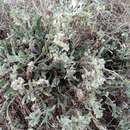ar
الأسماء في صفحات التنقل


Hormuzakia aggregata (Arabic: لسان الثور, Hebrew: לשון-שור מגובבת) is a flowering annual plant in the Borage family, known by the common name massed alkanet.[1][2][3]
It is a short-lived herbaceous plant with 10 to 50 cm (3.9 to 19.7 in) ascending hispid stems. The entire leaves are alternate, linear-lanceolate. It flowers from January to April, the small flowers are dark blue to violet producing 3 by 4 mm (0.12 by 0.16 in) hemispherical nutlets.[2]
The species name Hormuzakia derives from Constantin Freiherr von Hormuzaki a prominent Austro-Romanian naturalist. Anchusa derives from the Greek: αγχουσα, a plant used as a rouge. The epithet aggregata, derives from Latin and means to bring together or cluster.
It grows in Mediterranean woodlands, shrublands, shrub-steppes and deserts of Sicily, North East Egypt and the Sinai Peninsula, Libya, Algeria, Turkey, Cyprus, Lebanon, Israel, Rhodes, Saudi Arabia and the East Aegean Islands.[1][4]
The roots of Hormuzakia aggregata contain anchusin or alkannin (alkanet red), a red-brown resinoid pigment.[2][5] Alkannin is an antioxidant and has an antimicrobial effect against Staphylococcus aureus and Staphylococcus epidermidis. It is also known to have wound healing, antitumor, and antithrombotic properties.[6]
Alkannin is also found in the Chinese herbal medicine plant Lithospermum erythrorhizon, the red-root gromwell. The dried root is a Chinese herbal medicine with various antiviral and biological activities, including inhibition of human immunodeficiency virus type 1 (HIV-1).[7][8][9]
Hormuzakia aggregata (Arabic: لسان الثور, Hebrew: לשון-שור מגובבת) is a flowering annual plant in the Borage family, known by the common name massed alkanet.